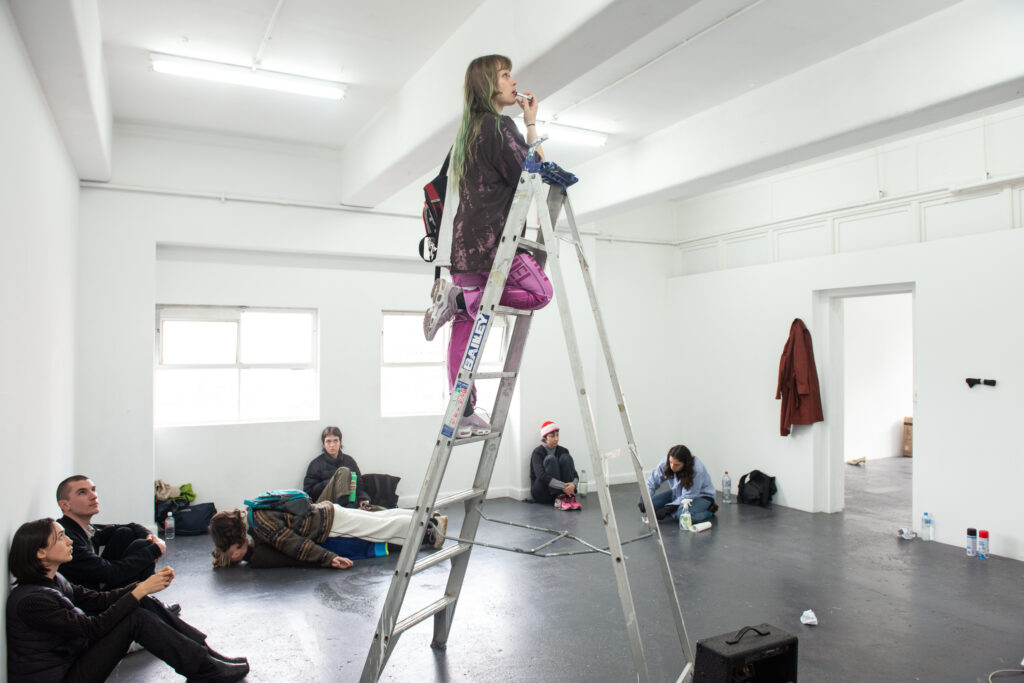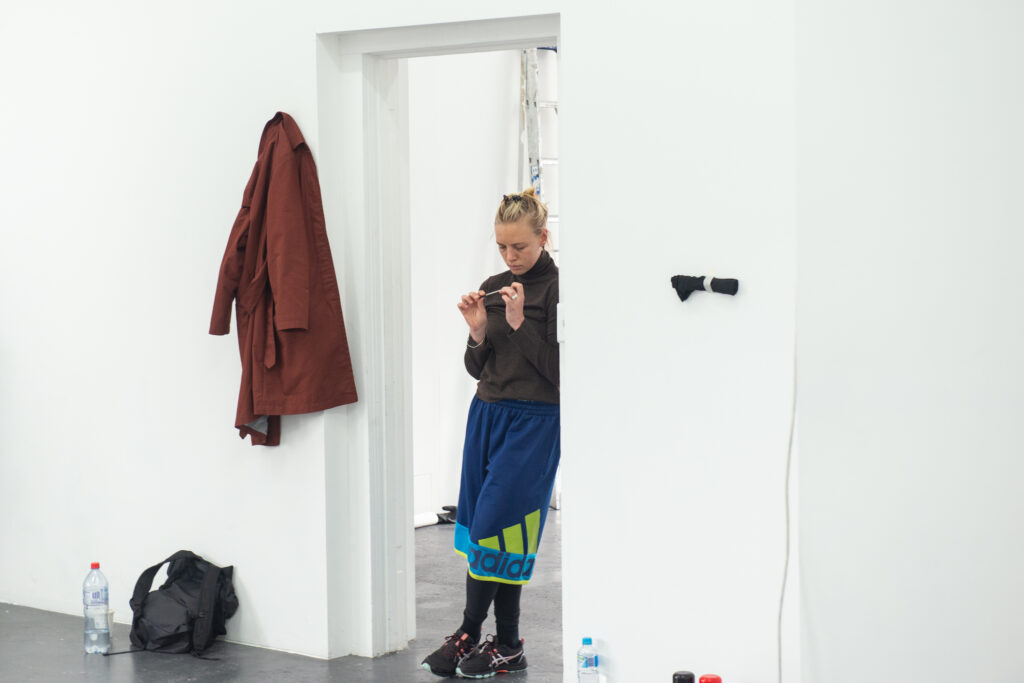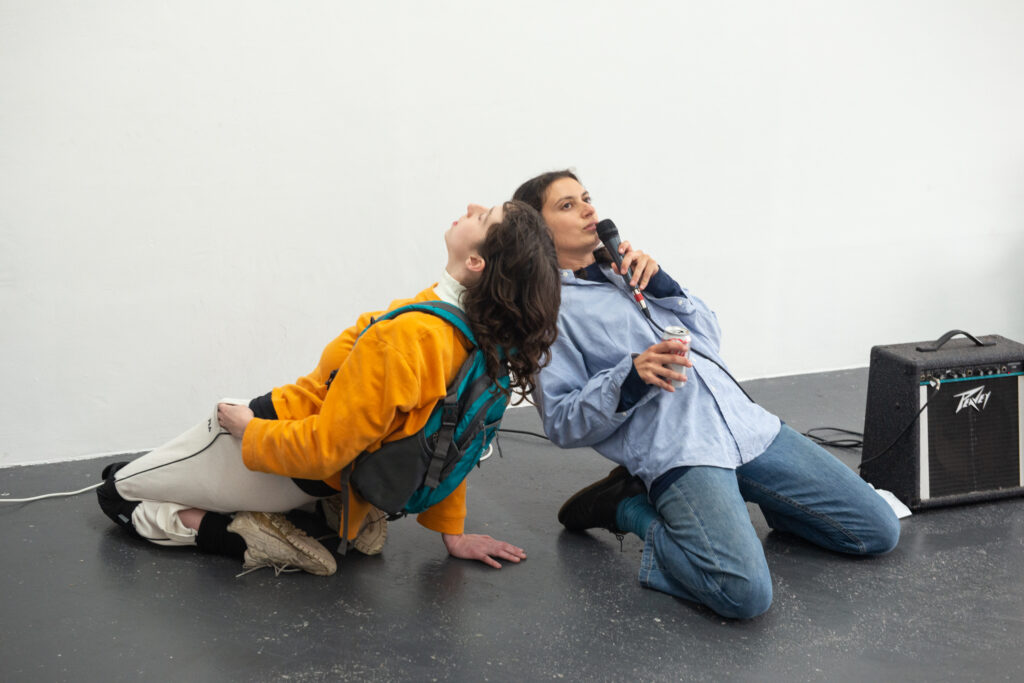Exhibition: methods for collapse (m4c)
Artist: Gabriella Imrichova
Performers: Roslyn Orlando, Sophie Gargan, Mara Galagher and Anika de Ruyter
Exhibition details: BLINDSIDE, 29 June – 16 July

Gabriella Imrichova, methods for collapse, 2022, live performance installation. Performers: Roslyn Orlando, Sophie Gargan, Mara Galagher and Anika de Ruyter. Photography: Nick James Archer
Gabriella Imrichova’s methods for collapse (m4c) ends with no capital E. Closure is a myth after all. After three, maybe four loops of the live performance score 0, I exit BLINDSIDE and feel nauseated. Though my nausea is better likened to a sensation of euphoric dizziness. Dizziness achieved by propelling one’s body in circle, after circle, after circle, after circle...
It is at this pressure point—where one’s orientation with the world meets the threshold of collapse—that I will begin to locate (and unlocate) the work in m4c. Gabriella’s practice is preoccupied with the notion of a ‘stumble’, a fixation (un)grounded by a queer desire to refuse fixity in pursuit of fluidity; the stumble itself, is a disorientation device. Revealing itself as a part-studio, part-creative development, part-site-responsive-performance, m4c refuses traditional modes of exhibition. I attended the work on two occasions: week one, writing the score and week two, performing the score, 0. 0 is devised by the artist Gabriella Imrichova and eroded by performers, Roslyn Orlando, Sophie Gargan, Mara Galagher and Anika de Ruyter. I will use the performers’ first names throughout this text to mimic Roslyn’s identifying of the performers during her part-stream-of-consciousness, part-narration, part-stand-up, part-stutter-to-articulate whatever it is that happens-to-be-happening in the moment she knows to pick up the microphone and speak.
Sophie spits a pool of water onto the gallery floor, a reflex which punctures her tepid balletic leap through the space. She returns to the safety of being held by and holding the door frame between gallery one and two, to go about the task of filing her nails. Roslyn bypasses Sophie —paper towels and multi-purpose spray in tow—to go about the business of cleaning up the liquid. Carefully salvaging the paper drenched in water, disinfectant and Sophie’s saliva, Roslyn commences her construction of a miniature swan sculpture. A monument to Sophie.

Having attended writing the score, I know not to mistake 0 for random meandering. What I have instead come to witness is a series of carefully constructed compositions. Gabriella has laid bare their creative process throughout the period of exhibition, allowing an opportunity for one to decipher the myriad of performative mechanisms at play. Enduring multiple loops of 0, an uncanny sense of déjà vu unfolds.
Roslyn stands atop a revolving platform slowly sucking on a Chupa Chups lollipop. Her blue jeans and baggy shirt are awkwardly mis-matched with a pair of pointed, modest-height heels, as if her feet are that of a teenager conservatively dressed for a school formal. The steady 360–degree rotation of her body teases me with seductive hints towards the erotic, and simultaneously unsettles me in its voyeurism of a child–like innocence.
This exploitation of the familiar through counter-intuitive processes of collage are ubiquitous throughout m4c. Performative paradoxes are conjured and looped in a never-ending foreplay between objects, bodies, sound and space. These poly-relations refuse hierarchisation, and in turn, any climactic release. Instead, the work skilfully holds the viewer in an extended state of anticipation.
The performers are busy. Busy going about the business of being Busy (capital B).
I liken the performers’ apathetic pottering to a tongue-in-cheek mimicry of the shackles of capitalist regime. Subtle hints towards consumerism are located via reoccurring ‘props’ such as cans of Diet Coke, Chupa Chups and chip-packet varieties. These items are mindlessly consumed and discarded haphazardly throughout the gallery, gradually forming an archive of bodily trace and detritus. Cameo appearances of high heels and Mara’s lathering of red lipstick atop a ladder are poised with an unnerving femininity. Sophie undresses from relaxed sportswear into a black power suit only to eat a packet of chips whilst scanning the room. The chip packets become my only key to identifying what cycle of the score I am in: Smiths Salt and Vinegar (loop one–two), Twisties (loop three), Burger Rings (loop four). Dark irony is coupled with ritualistic provocations.

Anika’s third (or fourth?) knee-slide across the gallery is accented by a hesitant backbend which allows her throat to be anointed by Roslyn’s offering of Diet Coke. A rare moment of unison sees Sophie, Annika, and Mara stand to assemble themselves in a triangular formation facing out towards the gallery window; gaze affixed beyond the glass. They slowly pump their right fists as if obediently following the swell of beats and bodies at a nightclub, yet their faces are devoid of ecstasy. An artificial tear drips down Anika’s cheek.
Ric Allsopp and Andre Lepecki describe choreography as an ‘apparatus of capture or a body-snatcher that seizes bodies in order to make them into other(ed) bodies’ 1. Gabriella utilises the score to capture the performer’s bodies, cleverly determining how they inhabit the gallery space. As with any durational artwork I encounter, some moments stain me more than others. For m4c, it is when Sophie’s deadpan expression is ruptured by a laugh; momentarily breaking her free from the score. It is at these points of slippage that I feel myself draw breath. These misalignments increase exponentially as the score undergoes a process of deterioration throughout the final week of the exhibition. Antithetical to Allsop and Lepecki’s definition of choreography, this decay of the score emancipates Gabriella’s ‘seized’ bodies, and consequently provokes questions regarding how bodies come to occupy, move through and take up space. What social and cultural choreographies do we subconsciously inherent? How do these bodily inheritances influence our movement? What occurs when they collapse?
What appears more crucial than any referential scaffolding I begin to build around m4c, is the way in which such scaffolding is at once formed and obliterated. In Materiality, Lang-Berndt suggests, ‘an object that gives in is actually stronger than one which resists, for which reason it also permits the opportunity to be oneself in a new way.’ 2 What is potent throughout m4c, is a queer desire for, and blind trust in ‘collapse’ as an artistic and cultural methodology imbued with possibility. The work serves as an antidote to the anchors of monotony (and much, much more). ‘Lord, increase my bewilderment’ 3, for if I have nothing left to know, then I must be dead.
Anna McDermott is an artist, writer and producer moving, working and creating in Narrm (Melbourne). Her installation-based practice employs photographic, filmic, sound and sculptural mediums to inform a practice concerned with the performative languages of space, the body, touch and spoken word. In 2020, she graduated from VCA with a Masters of Contemporary Art, for which she was awarded the Fiona Myer Art and Australia Internship. She has exhibited in various ARIs across Narrm and is a studio artist at Brunswick Temporary. Anna is currently working as Program Producer at Phillip Adams BalletLab at Temperance Hall.
This text was commissioned through the Emerging Writers’ Program. An annual collaborative project, from KINGS and un Projects, that supports critical arts writing, fiction, poetry, experimental, cross-genre and digital text forms. The Emerging Writers’ Program provides professional publishing opportunities and fosters dialogue between artists and arts writers. Each emerging writer in the program receives critical feedback and editorial assistance from KINGS and un Projects personnel.In 2022, the KINGS X un Projects Emerging Writer’s Program is supported by Creative Victoria through their Sustaining Creative Workers initiative.
